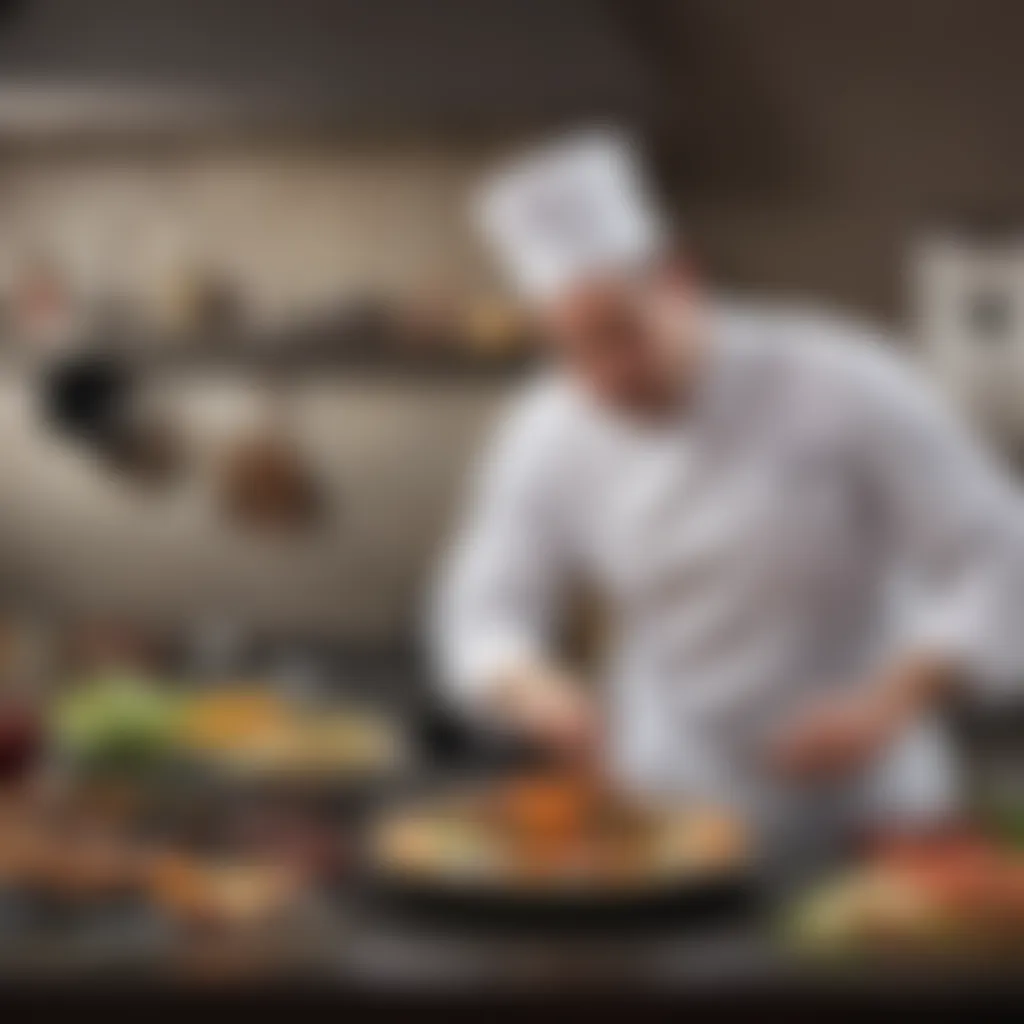Culinary Instructor Training: Techniques and Insights


Intro
Culinary education is not just about perfecting a recipe; it encompasses an art form of teaching and learning within the vibrant world of food. Nurturing the next generation of culinary professionals demands a robust training framework, one that goes beyond basic skills and incorporates essential methodologies, hands-on experiences, and technology integration.
In this exploration of culinary instructor training, we will dissect crucial components of the curriculum, the significance of mentorship, and how ongoing education shapes skilled culinary educators.
This comprehensive guide aims to illuminate every step in becoming an effective culinary instructor, enriching both educators and their aspiring students in the process.
Ingredients:
When beginning culinary instructor training, an essential first step is understanding the core ingredients that form the foundation of this educational journey. Here’s a detailed list of what a culinary educator needs:
- Flour: 500 grams
- Water: 350 milliliters
- Salt: 10 grams
- Yeast: 7 grams
- Olive Oil: 50 milliliters
- Herbs (Basil, Oregano): 2 tablespoons each
These ingredients symbolize more than just the items on a grocery list; they represent the various teaching elements that will be mixed together to create a successful culinary training environment.
Preparation Steps:
Detailed Instructions:
- Mixing the Dough:
In a large mixing bowl, combine the flour and salt. In a separate bowl, dissolve the yeast in lukewarm water and let it stand for about 10 minutes, until bubbly. Gradually mix the yeast mixture into the flour, kneading it into a soft dough. - Kneading:
On a floured surface, knead the dough for 10 minutes. This process is crucial; it builds the gluten, ensuring your students will have a solid foundation in bread making. - First Rise:
Place the kneaded dough in a lightly oiled bowl, cover it with a damp cloth, and leave it in a warm area until it doubles in size (approximately 1 hour).
Critical Techniques:
- Importance of Measurements: Precise measurements in cooking are non-negotiable. Educators need to instill this in their students, as even a minor deviation can lead to failure in the kitchen.
Cooking Process:
Sequential Steps:
- Shaping the Dough:
Once the dough has risen, punch it down and shape it according to the lesson plan. Educators should guide students on how to form various types of bread. - Second Rise:
Allow the shaped dough to rise again for about 30-45 minutes. This stage is essential for texture; it is where patience pays off. - Baking:
Preheat the oven to 220°C (428°F). Bake the bread for 25-30 minutes, until golden brown. Remind students to pay close attention to color and smell—both are indicators of doneness.
"Teaching kitchen skills is not merely about what is taught but how it is taught."
Troubleshooting Tips:
- Dough Not Rising: If the dough fails to rise, ensure the yeast is fresh and activated properly.
- Dry Bread: Monitor oven temperature closely. Too hot can dry out the bread.
- Underbaked Results: Always ensure the bread has a golden-brown hue before pulling it out; if in doubt, check with a toothpick.
This journey through the culinary education landscape sets the stage for understanding the importance of training not just in cooking, but in shaping educators and ensuring they can successfully pass on their knowledge. Stay tuned as we delve deeper into methodologies and the crucial roles that technology and mentorship play in this ever-evolving field.
Understanding Culinary Education
Culinary education lays the foundational stones for aspiring chefs and culinary instructors alike. The importance of grasping this domain cannot be overstated, particularly in the context of culinary instructor training. It is about more than just instructing students on how to sauté or bake; it’s about embodying a philosophy that ties together various aspects of food preparation, cultural appreciation, and the importance of technique.
One of the critical elements of understanding culinary education is the role it plays in bridging tradition and innovation. While knowledge of classic techniques is essential, today's culinary instructors must also embrace contemporary trends, which often blend diverse cultural influences. As students explore these intersections, they cultivate a more holistic view of culinary arts, enhancing their creativity and adaptability in the kitchen.
Benefits of Understanding Culinary Education
- Skill Building: An in-depth understanding of culinary education aids both instructors and learners in developing essential cooking skills. Instructors serve as the guides who help students navigate the intricacies of recipes, techniques, and flavors.
- Cultural Awareness: Food is often a reflection of culture. By understanding different culinary practices, instructors can enlighten students about the rich histories and traditions behind various cuisines.
- Enhanced Teaching Techniques: Knowing the educational models that exist within culinary training allows instructors to adopt the most effective methods for imparting knowledge, ensuring that their students excel.
Considerations About Understanding Culinary Education
As culinary education evolves, instructors must remain agile in their approaches. This field is marked by continuous change—whether it's arising from technological advancements or shifts in consumer preferences towards sustainable and ethical eating. Thus:
- Stay Updated: Instructors should invest time in professional development, keeping abreast of current trends and innovations that set the stage for modern culinary practices.
- Adaptability: Different students will respond to varying teaching techniques, so understanding how to tailor an instructional approach to meet diverse learning styles is invaluable.
"Education is the most powerful weapon which you can use to change the world." - Nelson Mandela
This sentiment rings especially true in culinary education, where instructors hold the power to shape not just immediate skills, but also the broader perspectives of their students.
Ultimately, understanding culinary education is about cultivating a community of learning that generates skilled, thoughtful, and innovative culinary professionals. It lays the groundwork for everything that follows in the journey of culinary instructor training.
Defining the Role of a Culinary Instructor
The role of a culinary instructor is multifaceted, enveloping both the art of cooking and the science of teaching. In the world of culinary education, the instructor serves as a bridge between tradition and innovation, handing down age-old techniques while encouraging creativity. Mastering this kind of equilibrium exemplifies the profound importance of this role within the larger framework of culinary training. For many aspiring chefs, instructors are more than just teachers; they become mentors, guiding students through the delicate blend of technique and culinary intuition.
Core Responsibilities and Skills
A culinary instructor wears many hats. Here are some core responsibilities and skills:
- Curriculum Design: Instructors must not only prepare engaging lesson plans but also adapt them to the different learning styles of their students. This requires understanding what works best in the kitchen and how to translate that into a classroom setting.
- Skill Development: Being proficient in culinary tasks is a must. Instructors should be able to demonstrate complex techniques with ease, making it clear how students can improve.
- Classroom Management: Maintaining a well-organized kitchen environment is crucial. Instructors need to balance authority and approachability, ensuring students feel comfortable asking questions while also respecting the professional setting.
- Assessment: Evaluating student performance is key, but it's done with a keen eye for nurturing rather than merely grading. Providing constructive feedback helps students flourish, which feeds into their confidence and skill.
Instructors must also possess a set of soft skills that enhance their teaching efficacy:
- Communication: Clear communication is essential to convey complex culinary concepts effectively.
- Patience: It takes time for students to master techniques, and an instructor should be patient enough to provide support throughout this learning curve.
- Passion: Enthusiasm for cooking can be infectious. An instructor’s passion often motivates students to dive deeper into their culinary studies.
"Great chefs aren’t just born; they’re forged in the fire of education and mentorship, guided by instructors who inspire and innovate."
The Rise of the Mentor Model


The mentor model of culinary instruction is on the rise, and for good reason. In a world increasingly focused on personalized learning, students benefit immensely from the one-on-one guidance that mentorship provides. This approach creates a more intimate learning atmosphere, where relationships blossom between instructors and students.
In this environment, culinary instructors don’t merely dispense knowledge; they share their experiences and passion. They guide students through failures and triumphs alike, embodying both teacher and coach. Here are some benefits of this shift toward mentorship:
- Personalized Guidance: Every student learns differently, and the mentor model allows for customization, tailoring the experience to each individual’s strengths and weaknesses.
- Building Confidence: Continuous support helps students push boundaries, which is essential in the culinary arts where experimentation often leads to breakthroughs.
- Networking Opportunities: A mentor can also introduce students to industry connections, helping them pave their path toward professional success.
Curriculum Development Strategies
Curriculum development is the bedrock of culinary education, guiding the path that instructors and students navigate through the culinary arts. As culinary programs evolve, striking a balance between foundational skills and innovative techniques becomes increasingly important. An effective curriculum not only lays the groundwork for novice chefs but also adapts to the ever-changing trends in the food industry. Thus, understanding and implementing curriculum development strategies is crucial for all culinary instructors aiming to foster a rich and impactful learning experience.
Identifying Key Learning Outcomes
In the realm of culinary education, identifying key learning outcomes is akin to mapping a route on a treasure hunt. It specifies what students need to know and be able to do by the end of their training. Defining these outcomes clearly ensures that both instructors and students have a shared understanding of what success looks like.
There are several elements to consider when determining these outcomes:
- Skills vs. Knowledge: Students should not only learn how to cook but also understand the why behind their techniques. For example, knowing the chemical reactions that occur when baking can improve their ability to troubleshoot problems.
- Student-Centric Goals: Outcomes should focus on what the students can achieve, ensuring they feel accomplished. Instead of vague goals, outcomes should be specific, measurable, and achievable. For instance, "Students will be able to execute five different knife cuts with precision."
- Industry Relevance: Keeping abreast of trends in culinary arts allows educators to incorporate essential skills needed in the workplace. This sometimes means adjusting learning outcomes to include current practices and emerging cuisines that reflect local tastes.
"By framing clear learning outcomes, culinary instructors pave the way for effective instruction that targets student success."
Creating Effective Learning Modules
Creating effective learning modules involves breaking down the curriculum into digestible sections that can be taught sequentially. These modules should not just dispense knowledge but also engage students in meaningful practice. The following aspects are vital when constructing these modules:
- Engagement: Interactive activities, like group cooking sessions, can significantly enhance learning. Students actively participating in hands-on practices are likely to retain information better compared to passive learning.
- Structured Content: Each module should start with an introduction outlining objectives, followed by content delivery that could include lectures, demonstrations, and hands-on tasks.
- Assessment Components: Including formative assessments like quizzes or practical tests within these modules keeps students on their toes and provides regular feedback.
- Comprehensive Resources: Providing students with access to additional resources—such as online culinary databases, textbooks, or articles—ensures they have multiple avenues to explore the subject deeply.
Integrating Theory and Practice
The integration of theory and practice is where the magic truly happens in culinary education. While theoretical knowledge forms the backbone of culinary skills, it is practice that breathes life into the art of cooking. Here’s how instructors can strike that vital balance:
- Practical Applications of Theory: For example, discussing the Maillard reaction in a lecture makes it easier for students to appreciate when they see the golden crust form on a seared steak in real life.
- Field Trips and Workshops: Exposing students to local farms, markets, and professional kitchens can enhance their understanding. These experiences connect classroom learning to real-world applications.
- Reflective Learning: Encouraging students to reflect on their performances after practical assessments helps them internalize what they’ve learned and understand areas for improvement. Journals or portfolios can be a good tool for this.
By weaving together theory and practice, culinary instructors can ensure their students don’t just learn to cook—they learn to think like culinary professionals.
Assessment Techniques for Culinary Training
Assessing the skill level of culinary students is a vital component of effective teaching in culinary education. It not only provides insight into students’ mastery of culinary techniques but also informs instructors about the effectiveness of their teaching methods. The right assessment techniques can significantly enhance both student learning and instructional strategies. By employing a range of assessment types, culinary instructors can address different learning needs, promote growth, and foster an environment conducive to creativity and skill enhancement.
Formative vs. Summative Assessments
When it comes to culinary training, understanding the distinction between formative and summative assessments is critical.
Formative assessments are those ongoing evaluations that occur throughout the learning process. They allow instructors to gather feedback while learners are still developing their skills. For example, a culinary instructor might conduct taste tests or kitchen performance reviews during a cooking class. This kind of evaluation helps instructors gauge students' understanding and proficiency in real-time, enabling them to adjust their teaching strategies accordingly.
On the other hand, summative assessments occur at the end of a course or unit. They serve as a final measure of what students have learned. An example would be a comprehensive exam or a final cooking demonstration showcasing the entire range of techniques that students have learned throughout the course. This kind of assessment summarizes the learning outcomes and allows for determining certification or grading.
Here's a quick comparison:
- Formative Assessments
Purpose: Ongoing feedback to enhance learning.
Examples: In-class cooking tests, peer reviews, quizzes.
Benefits: Identify gaps in understanding, allows for real-time adjustments by instructors. - Summative Assessments
Purpose: Measure overall learning at the end of an instruction period.
Examples: Final exams, thesis dishes, overall project assessments.
Benefits: Provides an overview of effectiveness and student proficiency.
Evaluating Practical Skills
In culinary education, practical skills take center stage. Evaluating these skills is not just about checking off a list of techniques but also about understanding how students apply their knowledge in real-world scenarios.
Practical evaluations may involve a combination of methods, including peer critiques, self-assessments, and performance rubrics, which outline specific criteria for success. For instance, if students are evaluating their knife skills, instructors can break down the assessment into various criteria such as technique, speed, and safety practices.
These on-the-spot evaluations can provide immediate feedback, allowing students to identify areas that need improvement. Furthermore, students often become engaged in their learning when they understand the criteria for their performance evaluations, leading to improved outcomes overall.
Feedback Mechanisms for Improvement
Feedback is essential in any teaching environment, especially in culinary training. It can be the catalyst for student improvement, turning an average cook into a skilled chef. Effective feedback mechanisms include structured assessments with clear rubrics and offering constructive comments on students’ performances.
Students should feel free to ask questions and seek clarification on their evaluations. A culture of open communication allows instructors to pinpoint specific areas where a student may struggle and offer tailored support. Moreover, offering feedback through a mixture of verbal discussions and written reports encourages accountability.
The Influence of Technology in Culinary Training
In the world of culinary education, technology plays a pivotal role that can't be ignored. From online platforms to multimedia resources, the integration of tech into training programs not only modernizes how culinary skills are taught, but it also offers diverse learning methods that cater to varying student needs. As we dissect the elements of technology's influence, it's apparent that its benefits extend far beyond mere convenience.
Online Learning Platforms and Resources
The rise of the internet has transformed the way culinary knowledge is imparted. Online learning platforms have become particularly significant, allowing students to access a broad spectrum of culinary courses at their own pace. Resources like Cook's Country and MasterClass provide engaging content that often features renowned chefs teaching their signature techniques. These platforms present a rich tapestry of information including videos, articles, and interactive quizzes designed to bolster learning.
Key Benefits of Online Learning:
- Flexibility: Students can learn whenever and wherever they choose, creating a more personalized learning experience.
- Diverse Content: Offers an expansive array of subjects, from baking to molecular gastronomy.
- Cost-Effective: Often, online courses are less expensive than traditional culinary schools, making them an accessible option.
However, while online platforms have their advantages, they may lack the hands-on component that's essential in culinary training. A balance between online learning and real-world experience is necessary to cultivate well-rounded culinary professionals.
Utilizing Multimedia in Instruction
Multimedia tools have redefined the parameters of culinary teaching. Instructors can incorporate video demonstrations, podcasts, and even interactive cooking apps to enhance understanding. The visual aspect of cooking aids in developing students' skills by giving them a clear picture of technique and workflow.


Several studies indicate that when students engage with varied formats of instruction, retention rates improve significantly. Here are several multimedia tools that can really make a difference:
- Video Tutorials: Watching a chef perform a technique is often more effective than simply reading about it. Websites like YouTube host many professional chefs showcasing tips and tricks.
- Cooking Apps: There are countless apps available that help students plan meals or track their cooking steps in real time.
- Interactive Simulations: Some programs simulate kitchen environments, allowing students to practice decision-making skills under pressure, much like they would during an actual service.
Future Trends in Culinary Education Technology
Looking ahead, the future of culinary education is poised for exciting transformations. As technology continues to evolve, several trends are likely to shape how culinary instructors approach teaching:
- Virtual Reality (VR) and Augmented Reality (AR): Imagine donning a VR headset and stepping into a virtual kitchen. These immersive experiences may provide unparalleled training that goes beyond traditional bounds.
- Artificial Intelligence (AI): Personalized learning experiences powered by AI could tailor classes specifically to the student's pace and skill level, adapting to their strengths and weaknesses over time.
- Sustainability through Tech: Educational programs may increasingly harness technology to teach sustainable practices, from sourcing ingredients locally to managing waste effectively in a kitchen environment.
As technology continues to infiltrate culinary education, educators must adapt and innovate to prepare students for a tech-savvy culinary world.
It's evident that the influence of technology in culinary training is multifaceted. By embracing online platforms, multimedia resources, and emerging technological trends, culinary instructors can motivate and equip the next generation of chefs to thrive in an ever-changing landscape.
Best Practices for Culinary Instructors
Culinary instruction is not just about pushing students through the motions of chopping and sautéing; it's about fostering an environment where they can thrive and cultivate a genuine passion for cooking. Establishing best practices in culinary teaching not only enhances the learning experience but also equips budding chefs with the skills and knowledge essential for a successful culinary career.
Understanding the nuances of this discipline can transform a traditional cooking class into a compelling adventure. Here we’ll unpack some core aspects that contribute to superior culinary instructor practices.
Building Positive Learning Environments
Creating a positive learning environment starts long before students set foot in the kitchen. It hinges upon crafting an atmosphere that nurtures creativity, curiosity, and camaraderie. Instructors should strive to be approachable, cultivating relationships where students feel valued and respected. An open dialogue where questions are welcomed encourages learners to engage more deeply with the subject.
A classroom that emphasizes safety and cleanliness is crucial, as it not only fosters respect for cooking practices but also enhances focus on skill development. To this end, consider the following:
- Use visuals: Demonstrating techniques visually can help students grasp concepts much more quickly.
- Celebrate small victories: Acknowledge individual progress, no matter how small. This builds confidence and encourages perseverance.
When students feel they are part of a community, they are more likely to participate effectively, share ideas, and learn from one another's experiences.
"The greatest gift an instructor can give students is a sense of belonging."
Adapting to Diverse Learning Styles
Every student brings a unique background and learning preference to the table. Therefore, culinary instructors need to be flexible and adaptable in their teaching approaches. Some students may excel through hands-on practice, while others grasp concepts better through lectures or visual aids. Embracing diverse teaching methods can make a significant impact.
Consider this simple guide:
- Kinesthetic learners: Engage with hands-on projects. Include practical cooking sessions where students can apply their skills directly.
- Visual learners: Use diagrams, videos, and infographics to illustrate techniques. Having a visual representation can greatly enhance retention of information.
- Auditory learners: Incorporate storytelling or discussions surrounding culinary theories and practices to engage these learners.
The diversity of learning styles is a treasure trove for culinary instructors, offering a rich fabric from which to design lessons that truly resonate with each student. The goal should be to utilize multiple modalities to cater for all learners in the classroom.
Fostering Collaboration Among Students
Culinary education thrives on collaboration. When students work together, they not only enhance their technical skills but also learn valuable teamwork and communication processes. Instructors can encourage group projects, cooking competitions, or peer teaching to allow students to share knowledge and techniques.
Here are some effective strategies to foster collaboration:
- Team Cooking Challenges: Create a setting where students are assigned to groups. Together, they can develop a menu and prepare a dish, emphasizing the importance of cooperation and shared responsibilities.
- Peer Feedback Sessions: After preparing their dishes, encourage students to provide constructive feedback to one another. This helps build critical tasting skills and enhances the learning experience.
- Discussion and Reflection: After collaborative exercises, facilitate discussions on what worked well and what challenges were faced, creating a culture of reflection.
By promoting collaboration, culinary instructors not only enhance the learning experience but also prepare students for future roles in the industry where teamwork is often essential. It arms them with interpersonal skills that will serve them well beyond their culinary education.
In summary, effective culinary instruction requires more than just technical skills. Best practices revolve around fostering a positive environment, adapting to diverse learning styles, and encouraging collaboration. Integrating these elements can greatly enhance the educational experience and prepare students for a successful career in the culinary arts.
Cultural Competence in Culinary Education
Cultural competence in culinary education serves as a foundational pillar in training future culinary instructors. As the global dynamism of cuisine increases, instructors mustn't only be educators but also cultural ambassadors. By fostering an understanding of diverse culinary traditions, instructors empower students to appreciate and innovate beyond their culinary norms. This isn’t just a nice-to-have; it’s a must for students who will enter a workforce that values inclusivity and innovation rooted in multicultural appreciation.
Benefits of Cultural Competence
- Enhanced Creativity: Exposure to various culinary practices encourages creativity. When instructors share their knowledge about different cuisines, students are likely to create dishes that blend various traditions.
- Better Communication: Understanding different cultures lead to improved relationships among students from diverse backgrounds. This includes both communication and collaboration in the kitchen.
- Global Understanding: Culinary instructors who embrace cultural differences can teach students why food is significant in different societies, thus broadening their global perspective.
- Community Engagement: Instructors can engage with local culinary traditions, linking education to the communities they serve. This often fosters goodwill and student pride in their culinary heritage.
"Culinary education is not just about teaching techniques; it’s about connecting hearts and the history behind the food we create."
Understanding Global Culinary Traditions
The appreciation of global culinary traditions is critical in culinary educator training. Instructors need to comprehend the historical context and evolution of food practices across cultures. For instance, understanding how spices influenced trade, or how geography affected food availability, can provide context in lessons. Culinary traditions are not only recipes; they tell stories of the people, their struggles, their commitments, and their celebrations.
This understanding can be brought into the classroom in various ways:
- Guest Speakers: Invite chefs from diverse culinary backgrounds to share their experiences and cooking methods.
- Cultural Events: Organize theme days where students prepare dishes from various cuisines. This hands-on approach solidifies learning by doing.
- Field Trips: Visiting local ethnic markets or restaurants can enhance practical learning and support local businesses.
Incorporating Cultural Awareness in Curriculum
Integrating cultural awareness into the culinary curriculum is essential for producing well-rounded culinary professionals. The curriculum should not just be a list of technical skills but rather a rich tapestry of cultural narratives woven through the fabric of every dish.
Curriculum Ideas:


- Recipe Analysis: Encourage students to analyze traditional recipes from multiple cultures, considering ingredients, preparation methods, and historical context.
- Culinary History Lessons: Regular segments on the history of ingredients, dishes, and cooking techniques across the globe help contextualize what students are learning in a way that resonates.
- World Cuisine Weeks: Designate certain weeks to explore a region's cuisine deeply, covering everything from cooking techniques to the sociopolitical impacts on food.
By thoughtfully embedding cultural competence into the educational framework, culinary instructors can ensure that their students not only become skilled chefs but also compassionate and informed custodians of the culinary traditions they inherit and evolve.
The Role of Industry Partnerships
In today's fast-paced culinary scene, forging strong ties with industry partners stands out as a crucial component in culinary instructor training. These partnerships serve not only to enrich the curriculum but also to provide students with invaluable exposure to real-world environments. When culinary programs collaborate with local businesses, restaurants, and relevant organizations, they create a bridge between academic learning and practical application. This connection is vital for preparing students to navigate the dynamic world of culinary arts effectively.
One key element to consider is that industry partnerships can lead to enhanced resources and opportunities for both students and instructors. With support from the culinary industry, schools may access up-to-date equipment, technologies, and even guest instructors who bring fresh perspectives and experiences. Additionally, businesses might be more inclined to offer sponsorship for events or equipment, making the overall training experience richer.
Benefits of these collaborations include:
- Real-World Experience: Students gain hands-on experience and insights from actual professionals in the field.
- Networking Opportunities: Developing connections in the industry can open doors for internships and job placements after graduation.
- Curriculum Relevance: Feedback from industry experts allows culinary programs to tailor their curricula to meet evolving job market requirements.
Overall, when culinary programs align their aims with the industry’s needs, they cultivate a more resourceful and responsive educational environment, producing highly sought-after graduates.
Collaborations with Local Businesses
Collaborating with local businesses plays an essential role in crafting a culinary education that values community ties and practical experience. When culinary schools partner with nearby restaurants, catering companies, or food producers, both students and instructors benefit. Such collaborations often lead to mutually beneficial relationships where students contribute fresh ideas while gaining access to hands-on experiences.
These partnerships may provide:
- Shared Resources: Culinary institutions can gain access to better facilities, specialized equipment, and industries’ insights.
- Events and Competitions: By working together, schools and businesses can host culinary competitions or festivals that highlight local flavors and talent.
- Workshops and Classes: Local chefs can lead cooking workshops, offering students direct instruction and guidance.
Engaging with local entities not only enriches the curriculum but also roots the program in the community it serves, fostering a sense of pride and belonging among students.
Internship Opportunities for Students
Internships act as a cornerstone for culinary education, bridging the gap between theory and practice. Industry partnerships pave the way for ample internship opportunities, allowing students to work in a variety of settings—from upscale restaurants to community kitchens. Through these experiences, students learn to apply their skills, collaborate with others, and adapt to the demands of a workplace.
Internships can provide:
- Skill Development: Practical experience enhances students' skill sets beyond classroom learning, particularly in fast-paced environments.
- Professionalism: Experiencing the work culture firsthand prepares students for the expectations they will encounter in their careers.
- Career Path Exploration: Internships expose students to different career paths and roles within the culinary industry, helping them decide where they want to focus.
"Internships are like a testing ground for students, allowing them to find their footing and learn on the job while building essential connections."
Internship experiences, facilitated through industry partnerships, are crucial in cultivating well-rounded culinary professionals ready to tackle the challenges of an ever-evolving sector. Emphasizing the significance of these arrangements in culinary instructor training highlights their role in producing skilled chefs and educators.
Continuing Education for Culinary Instructors
Continuing education holds immense value in the realm of culinary instruction. It’s not just about teaching students how to cook; it’s about molding educated professionals who can adapt in a constantly changing culinary landscape. An effective culinary instructor must not only pass on their skills but must also engage in ongoing professional development, which plays a pivotal role in enhancing their teaching effectiveness.
Importance of Professional Development
Professional development is crucial for culinary instructors, as it directly impacts both their teaching abilities and their students’ learning experiences. As culinary trends evolve, so too must the knowledge and techniques of instructors. Here are key reasons why ongoing education is essential:
- Staying Current with Trends: The culinary world rarely stands still. From food science innovations to emerging dietary trends, continuous learning ensures instructors remain relevant. For example, keeping up with plant-based cooking or sustainability practices can enrich the curriculum.
- Skill Refinement: Even seasoned chefs need to refine their skills regularly. Workshops focusing on specific techniques, such as mastering sous vide cooking or artisan bread making, help instructors improve their personal skills. Ultimately, this benefits their students.
- Networking Opportunities: Attending conferences and workshops allows educators to meet industry professionals. These connections can open doors for student internships and job placements or foster collaborative projects that enhance the educational environment.
"Inspiration comes from experience, and experience comes from continuous learning."
Instructors who embrace lifelong learning set a powerful example for their students. By prioritizing their development, they demonstrate a commitment to culinary arts that students can aspire to emulate.
Accessing Workshops and Seminars
For culinary instructors intent on enhancing their skills, accessing workshops and seminars can provide a wealth of information, inspiration, and practical applications. Here are some considerations:
- Research Availability: Various culinary schools and culinary institutes frequently host workshops tailored for instructors. Online platforms can also be a treasure trove for virtual seminars.
- Join Professional Organizations: Becoming a member of associations like the American Culinary Federation allows instructors to gain access to exclusive workshops, resources, and continuing education credits.
- Seek Regional Opportunities: Local universities or community colleges may offer workshops that focus on regional cuisines or culinary innovations pertinent to their area.
- Leverage Online Resources: Numerous online platforms, including large programs such as Coursera or specialized culinary sites, provide opportunities for instructors to learn at their own pace.
The importance of continuing education in culinary instructor training cannot be understated. By actively pursuing further professional development and accessing workshops, educators can grow, inspire their students, and contribute richly to the culinary field.
Challenges in Culinary Instructor Training
Training culinary instructors entails navigating a landscape filled with numerous challenges. These challenges are not mere obstacles; they are critical elements that can deeply affect the caliber of education delivered and the overall effectiveness of the instructor. Acknowledging these issues brings to light the pressing need for innovative strategies and frameworks integral to fostering a new generation of culinary professionals.
In the world of culinary arts, instructors stand at the confluence of tradition and innovation. It's vital they stay ahead of skill gaps prevalent in this fast-paced industry. This requires a continual reassessment of their teaching methods to ensure that new chefs are equipped with both classical techniques and modern culinary practices. Moreover, industry dynamics constantly shift, influenced by trends, technological advancements, and evolving consumer preferences. Culinary educators must adapt fluidly, integrating these changes into their training modules to provide relevant guidance for their students.
Addressing Skill Gaps
Skill gaps in culinary education can be a thorn in the side of effective teaching. Many aspiring chefs enter culinary schools with varying levels of basic cooking knowledge, which can make it difficult for instructors to plot a course for their education. Some students may be familiar with kitchen procedures and equipment, while others are still learning to chop an onion.
Therefore, educators must implement tailored instructional methods, allowing for differentiated learning experiences. Here are a few approaches:
- Assessment of Prior Knowledge: Before the course begins, understanding the skills and knowledge of each student helps instructors tailor lessons.
- Hands-on Workshops: Incorporating practical, hands-on workshops helps bridge the gap between theory and practice. Students benefit from real-world applications of their skills in a controlled environment.
- Peer Mentorship: Dynamics in classrooms can also be helpful. Allowing those with more advanced skills to mentor their peers helps everyone progress.
Such strategies not only assist in bridging skill gaps but also encourage a more inclusive learning environment where every student feels valued and encouraged to participate.
Navigating Industry Changes
The culinary landscape is ever-evolving, presenting instructors with the ongoing task of staying abreast of trends, practices, and consumer demands. Navigating these industry changes is paramount to keep culinary programs relevant and effective.
Instructors must constantly evolve their curriculum to reflect:
- Sustainability Practices: As consumers become more environmentally conscious, integrating sustainable cooking practices is essential for modern culinary training. This includes farm-to-table concepts and responsible sourcing of ingredients.
- Dietary Inclusivity: With rising awareness around dietary restrictions, culinary programs must adapt to include education on vegan, gluten-free, and allergy-conscious cooking.
- Technological Advances: New technologies, such as food delivery apps and cooking equipment like sous-vide, change how culinary art is practiced. Educators must incorporate training on these technologies to better prepare their students.
"To thrive as culinary instructors, adaptability in teaching methods as well as curriculum design is crucial; the world of culinary arts waits for no one."







